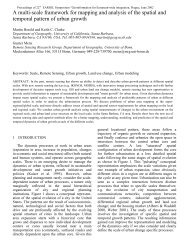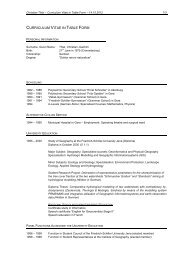Using Geomatica Software - Fernerkundung Jena - Friedrich ...
Using Geomatica Software - Fernerkundung Jena - Friedrich ...
Using Geomatica Software - Fernerkundung Jena - Friedrich ...
Create successful ePaper yourself
Turn your PDF publications into a flip-book with our unique Google optimized e-Paper software.
STARTER<br />
WTRSHED<br />
Watershed Seed Starter, Performs an interactive procedure to<br />
create a starter data set for specific watershed delineation or<br />
overland path determination<br />
Watersheds from Elevation Data finds the specific watersheds or<br />
sub-watersheds using the results from STARTER or SEED.<br />
3.5 EASI- Programmierung<br />
Ein EASI-Macro enthält eine Reihe von EASI-Anweisungen (siehe Manual EASI User<br />
Guide), die im Texteditor eingegeben und gespeichert werden (die Extension ist .eas,<br />
z.B macro_1.eas) Macros werden mit einer Run-Anweisung im EASI-Window gestartet<br />
(EASI>r dir ; s. weiter unten). Einfache Macros enthalten eine Aneinanderreihung von<br />
Programm-Parametereingaben und Run-Anweisungen (r cim). Textvariable (z.B. file)<br />
müssen in Hochkomma gesetzt werden.<br />
Einfache Prozeduren enthalten eine Aneinanderreihung von Parameterangaben und eine<br />
RUN-Anweisung. Ausgefeilte Prozeduren können aber auch vom Benutzer Eingaben<br />
abfragen, On-Line Hilfe beinhalten, Unterprozeduren aufrufen, arithmetische Funktionen<br />
ausführen und anderes mehr.<br />
In EASI-Prozeduren können sowohl permanente Variable, die in das Parameter-File<br />
(PRM.PRM) eingetragen sind, auftreten, als auch temporäre Variable, die nur während<br />
des Ablaufes einer bestimmten Prozedur zur Verfügung stehen. Für viele Prozeduren sind<br />
die im Parameter-File vorhandenen Variablen (z.B. DBIC, ESCALE) und einige temporär<br />
definierte Variable (z.B. #A, $B) ausreichend. Findet eine bestimmte Variable immer<br />
wieder in verschiedenen Prozeduren Verwendung, kann der Benutzer diese mit dem<br />
Befehl DEF ins Parameter-File aufnehmen.<br />
“EASI, the Engineering Analysis and Scientific Interface, is both a command<br />
environment for interactive executing tasks and a scripting language for the construction<br />
of applications. EASI is independent of its host environment and eliminates the<br />
differences between host operating systems, presenting the user with a simple, powerful<br />
environment. As a command environment, EASI provides a simple and convenient<br />
mechanism for querying and setting input parameters required by an executable module,<br />
referred to as a “task”. The interactive user is able to view a complete list of all the<br />
parameters required as input by a task, check their current values, modify their values,<br />
and execute the task. As a scripting language, EASI can be used to automate those<br />
manual procedures that are performed by a user interactively.<br />
A set of commands can be placed in an ordinary text file, called an EASI script, to specify<br />
parameter values and execute tasks. Chains of such commands in an EASI script can be<br />
used to automatically compute more complex or time-consuming results. In addition to<br />
support for simple automation scripts, the EASI scripting language includes a complete<br />
set of control structures with which complex applications can be built. EASI also includes<br />
a rich set of intrinsic functions which permit the manipulation of data in a platform<br />
independent way. Examples of data that can be accessed and manipulated include raster<br />
imagery, vector data, projection information, and general binary and text files.“<br />
(EASI/PACE Reference <strong>Geomatica</strong> 8.2)<br />
Eine Beispielroutine ist wird in Abb.4 vorgestellt und kommentiert:<br />
!EASI<br />
! Rev1. 11.8.2003 (docu and the initial statements)<br />
!<br />
! EASI Routine by SHese 82003<br />
!






